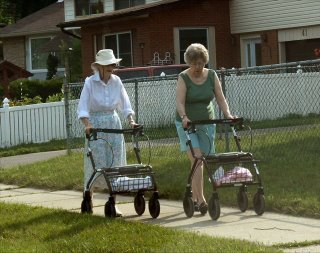 The parallel bars in the therapy room at the hospital are used frequently in gait training for our patients. No one in our program practices ballet demi-plies or pirouettes in the bars. Instead, legs with grinding joints, weakened muscles and heavy feet, are dragged along with the support of the arms and one or two assistants. Many patients get stronger and are able to walk out of the room with a walker or cane, while others end up in wheelchairs indefinitely.
The parallel bars in the therapy room at the hospital are used frequently in gait training for our patients. No one in our program practices ballet demi-plies or pirouettes in the bars. Instead, legs with grinding joints, weakened muscles and heavy feet, are dragged along with the support of the arms and one or two assistants. Many patients get stronger and are able to walk out of the room with a walker or cane, while others end up in wheelchairs indefinitely.Recently, we admitted two sweet ladies, roommates, one 96 and the other 93 years old, who had each fallen and broken a hip. They are both frail and weak, but were bright and ready for therapy every day. We would tease them about their combined age and wisdom of 189 years. Dottie and Trudie would be positioned in their wheelchairs at either end of the bars and would take turns trying to walk towards the other. Dottie, the 96 year old would go first and could move about eight steps before she needed a rest. She would then tell Trudie, You’re only 93. Come on, you can do it!” Trudie’s knees were in bad shape and would buckle when just standing. Dottie then would take a scriptural approach and say, “All things are possible to them who believe,” and Trudie would take a step, then another and another, a big smile on her face. She could not disappoint her cheering section.
Last week, Dottie became weaker, stopped eating and needed to be transferred out to the acute care hospital. Trudie has been despondent and hasn’t had the strength to even stand half way out of her chair.

I have worked in the community since 1995 and have visited about 2000 different patients in their homes in the past eleven years. I keep a log off the various conditions I see and have found that the number one reason for a home therapy visit is a fractured hip. The elderly people we see today were not treated early for osteoporosis, and many suffer more than one broken bone, usually a hip, but frequently a shoulder, wrist, pelvis or vertebra. There are screening tools and effective medications available to lessen the chances of these outcomes, but people are still often under diagnosed and under treated.
We are told that 25% of people with hip fractures will die within a year, and this will undoubtedly be true for these ladies. Trudie is aware of this and philosophically told me, “You can’t tell life what to do.”
Well, we don’t give up, for as long as there is life there is hope. Those who survive may do so because they have a will and a purpose for living, or perhaps because someone is there to cheer them on.
No comments:
Post a Comment
Note: only a member of this blog may post a comment.